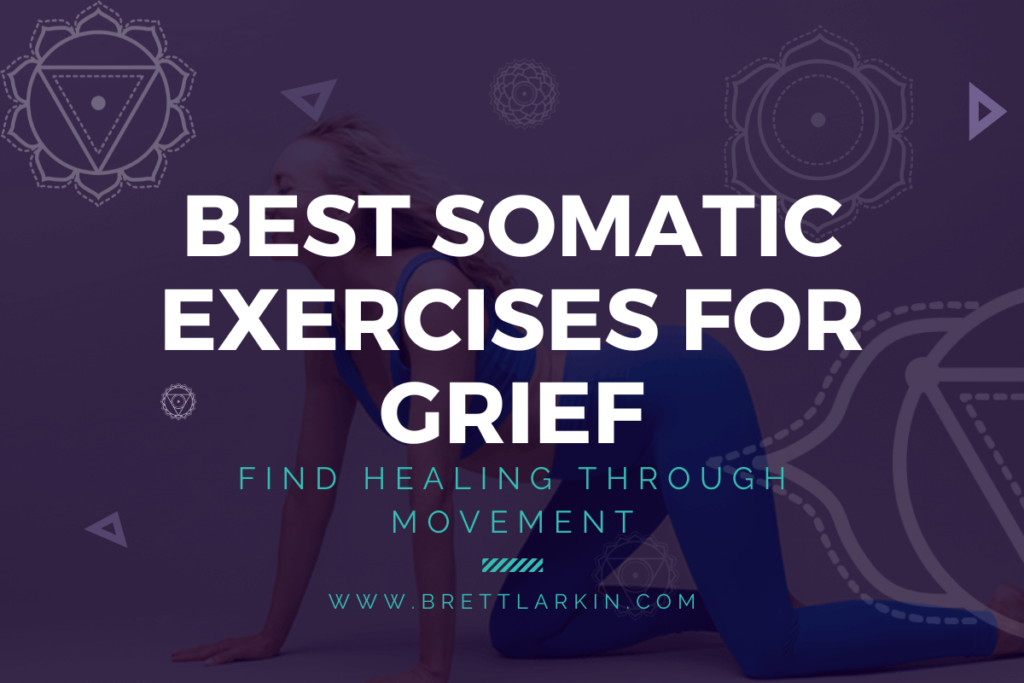Grief is a normal part of the human experience. Everyone will experience loss at some point in their life, and for some this particular emotion can be crippling.
Thankfully, there are many kinds of grief support out there, from group meetings to grief specific coaching/therapy. But what if this kind of traditional talk therapy isn’t enough? What if you talk and talk about your grief but most days you still feel like your heart is aching? It might be time to take a different therapeutic approach, one that focuses on how the body feels, rather than what’s going on in your head. A more somatic approach…
How Grief Impacts The Body

Grief can trigger physical symptoms such as fatigue, muscle tension, chest tightness, digestive issues, and headaches, often as a result of prolonged stress and emotional overwhelm. It activates the nervous system’s fight, flight, or freeze response, which can lead to a host of physical sensations: chronic pain, sleep disturbances, depression, and weakened immunity if left unresolved. Some of the most common physical manifestations of grief are:
Inflammation – grief has been shown to compromise the immune system, leading to greater levels of inflammation in different parts of the body.
Cortisol dysregulation – strong emotions have been associated with cortisol dysregulation. This can lead to sleep problems, weight gain, as well as other physical ailments.
Pain – the inflammation that can arise during the grieving process can lead to physical pain by making the body’s pain receptors more sensitive.
Digestive problems – from loss of appetite to overeating, grief can cause different types of digestive problems.
Heart function – chest pain, shortness of breath, and arrhythmia are all symptoms of broken heart syndrome. Yes, broken heart syndrome is a real thing and can be triggered by major emotional events that lead to grief and loss.
It’s important to understand that grief is not just an emotional experience but a full-body event that requires both mental and physical processing. Just like all emotions, it serves a purpose. Your grief is asking you to slow down, to pause, fully feel and release. If you try to suppress or push it away it will store itself somewhere, most likely in your body. You can use somatic practices, like gentle yoga and mindfulness, to help you reconnect with your body, release tension, and process grief in a safe, nurturing way.
Take my feminine energy quiz to get a recommended practice for balancing YOUR feminine energy 👇
How Do You Release Grief Somatically?

Releasing grief somatically involves engaging the body through movement, breathwork, and sensory awareness to process and release stored emotional tension. Techniques such as somatic yoga, shaking, or deep diaphragmatic breathing allow emotions tied to grief to surface and dissipate naturally, helping to close the stress cycle and restore balance to the nervous system.
Peter Levine, the father of somatic experiencing, often explains that trauma stems from overwhelm. That whenever your system experiences overwhelm or perceived threats without being able to complete the stress cycle(fight/flight/freeze) it results in trauma. Grief occurs from the overwhelm of loss. He also explains that when healing, you can’t just go right for the source of the trauma to release it; that it takes small amounts of sensation or emotion at a time to release. You have to take time with the grief, and then time away from the grief, going slow. This is known as titration and pendulation.
Because grief is deeply personal and physical, often residing in the body long after the mind has begun to process it; the healing process may look different for everyone. Somatic practices like somatic yoga, tai chi, or somatic experiencing give you a safe, non-verbal way to reconnect with these emotions and let them move through you. Through gentle movement and deeply connecting you to your physical bodily sensations, these practices encourage healing from within and foster a sense of wholeness.
Somatic Healing Masterclass: Rewire Trauma, Reclaim Your Intuition (usually $67) FREE👇
FREE Feminine Form Embodied Yoga Masterclass (usually $67) Unleashing Pleasure + Intuitive Movement on the Mat

Best Somatic Exercises For Grief
Studies have shown somatic therapy techniques like progressive muscle relaxation and body scanning can lessen the severity of grief and improve its physical manifestations. Personally, when working with grief, I love movements that open up the front and back of the heart space(where grief often lives). But the biggest thing to start with when working with an emotion like grief is creating a safe, non-judgmental space to practice in. Once you have that you can start your practice. Some of my favorite movements are listed below, but I also have this beautiful somatic class for emotional release you can do:
1. Child’s Pose (Balasana)
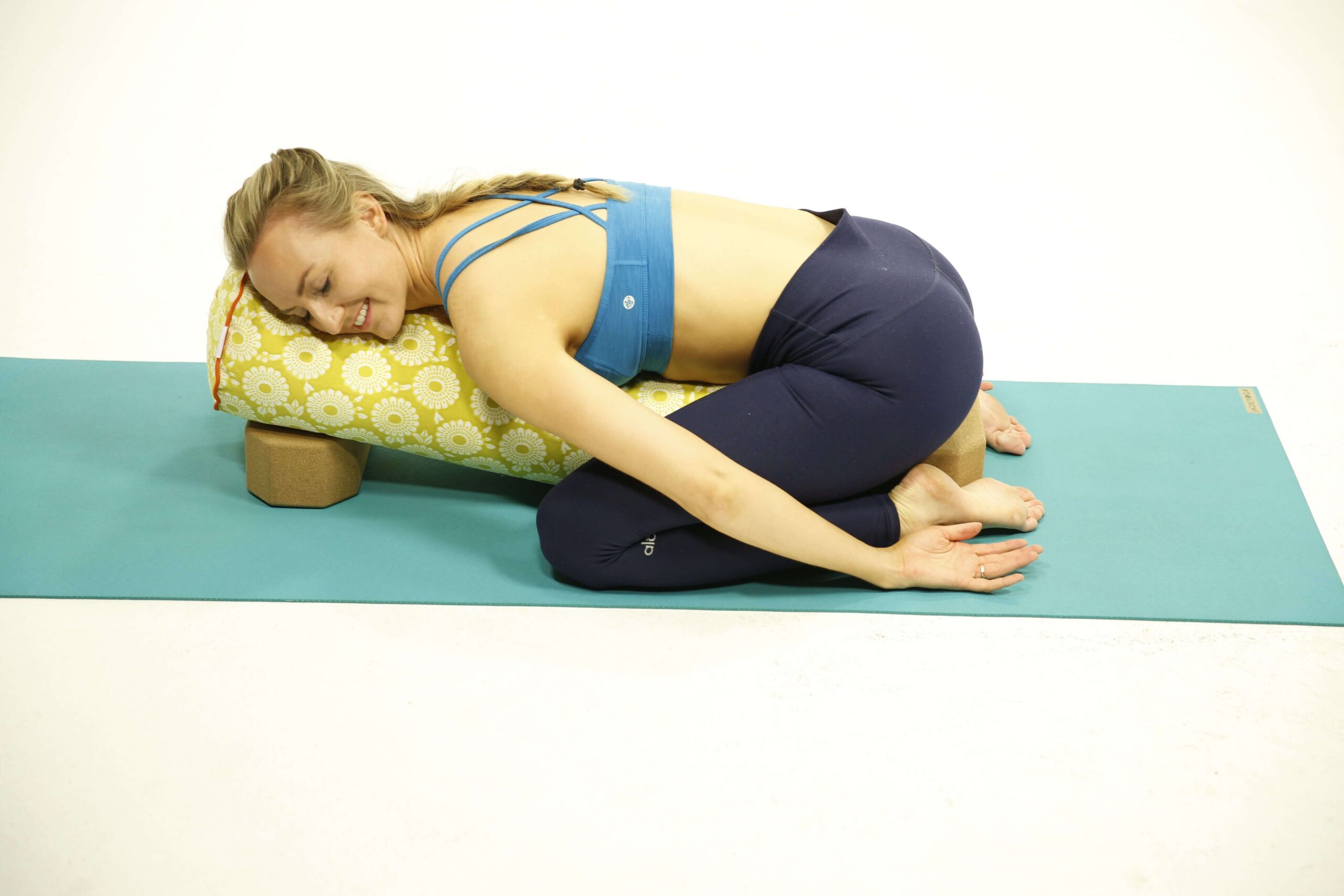
Steps to Practice:
- Start in a kneeling position, bringing your big toes together and knees apart.
- Sit back on your heels and bring your arms forward on the mat, resting your forehead on the mat.
- Breathe deeply, focusing on releasing tension with each exhale.
- Stay for 1-2 minutes or longer as needed.
Variations:
Place a bolster under your chest for support or blocks under the palms in extended child’s pose for a deeper chest opener. Keep your arms by your sides if stretching forward feels too intense.
Benefits:
Releases tension in the lower back and hips. Grounds and creates a greater sense of safety in the nervous system.
Pro Tips for Yoga Teachers:
- Ask students to undulate between a child’s pose and sitting back on their heels using the arms as support.
- Offer affirmations of safety to help students feel as comfortable as possible: “I am held”, “I am safe”, “I survived”, “There is nothing to do but let yourself feel completely supported by the floor”.
2. Cat-Cow Pose (Marjaryasana-Bitilasana)
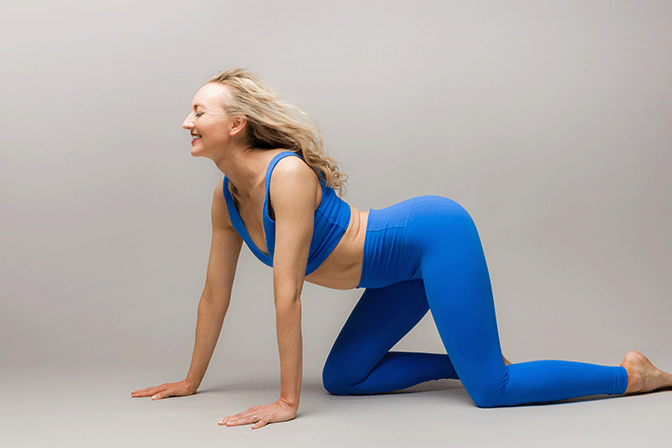
Steps to Practice:
- Begin in a tabletop position (on hands and knees).
- Inhale, drop the belly to arch your back and lift your head and tailbone (Cow).
- Exhale, round your spine and tuck your chin and pelvis (Cat).
- Flow gently between these two poses for 1-2 minutes.
Variations:
Pad the knees with a blanket or perform on the forearms. This can also be done in a seated position. Add hip circles for more intuitive movement.
Benefits:
Loosens the spine and reduces tension in the back. Expands and contracts the heart space and synchronizes breath and movement for emotional release.
Pro Tips for Yoga Teachers:
- Encourage students to use this pose as a bridge to intuitive movement. Doing whatever feels right in their body, leaning into the sensations that feel best.
- Offer phrases to guide emotional processing during the flow, “how does your grief want to move through you right now?” “Where do you feel the grief in your body? Lean into it”.
3. Reclined Bound Angle Pose (Supta Baddha Konasana)

Steps to Practice:
- Lie on your back, take the soles of your feet together as your knees naturally fall open.
- Place one hand on your heart and the other on your belly.
- Breathe deeply and relax into the pose for 3-5 minutes.
Variations:
Use blocks or cushions under the knees for support. Add a bolster or block to lie your spine for a heart-opening variation.
Benefits:
Opens the hips and chest, areas where grief is often stored. Balances hormones like cortisol and promotes deep relaxation and emotional release.
Pro Tips for Yoga Teachers:
- Pendulate here: move with the breath going between the arms in goal posts(heart extension) and bringing the elbows in toward each other/hugging yourself(heart contraction).
- This can be a nice place to have students place their hands on their bellies and practice diaphragmatic breathing.
4. Head to Knee Pose (Janu Sirsasana)
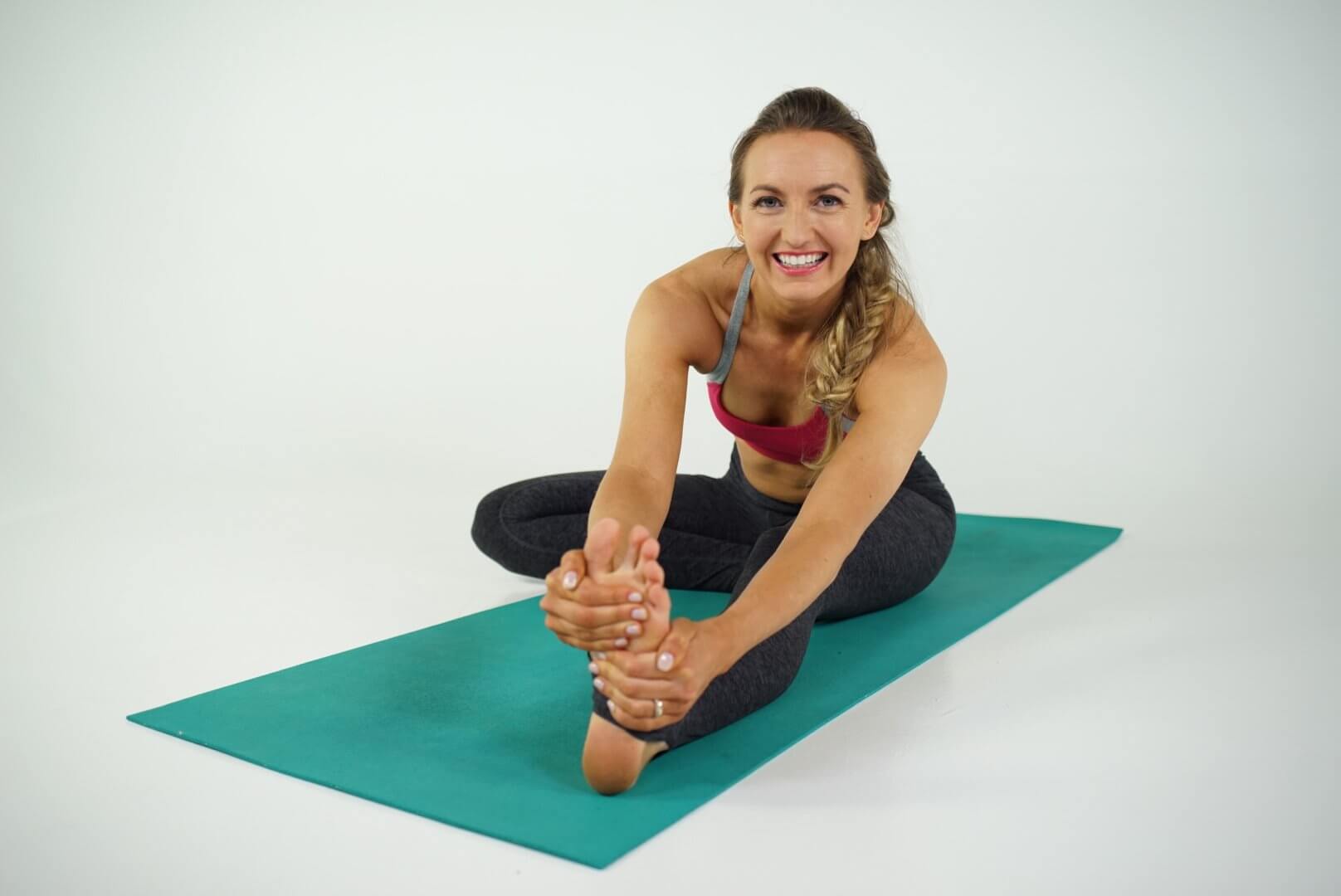
Steps to Practice:
- Sit with one leg extended, the opposite knee bent and the sole of foot against the thigh of the extended leg. Keep the spine tall.
- Inhale, reach your arms up, and exhale as you fold forward from the hips over the extended leg.
- Rest your hands on your leg, foot, or the floor, and hold for 1-2 minutes.
- Slowly come back to sit tall and switch sides.
Variations:
Bend the knee slightly if your hamstrings are tight. Place a bolster or blocks on your legs to rest your chest.
Benefits:
Emotionally grounding pose, calming the mind and easing anxiety. Stretches the low back and hips relieving tension.
Pro Tips for Yoga Teachers:
- Undulate here, moving with the breath. Inhale rolling the spine up one vertebrae at a time, exhale lead with the chin and you fold back over the leg.
- Offer students the option to slowly rock and sway the upper body back and forth holding space for whatever comes up.
5. Legs-Up-The-Wall Pose (Viparita Karani)
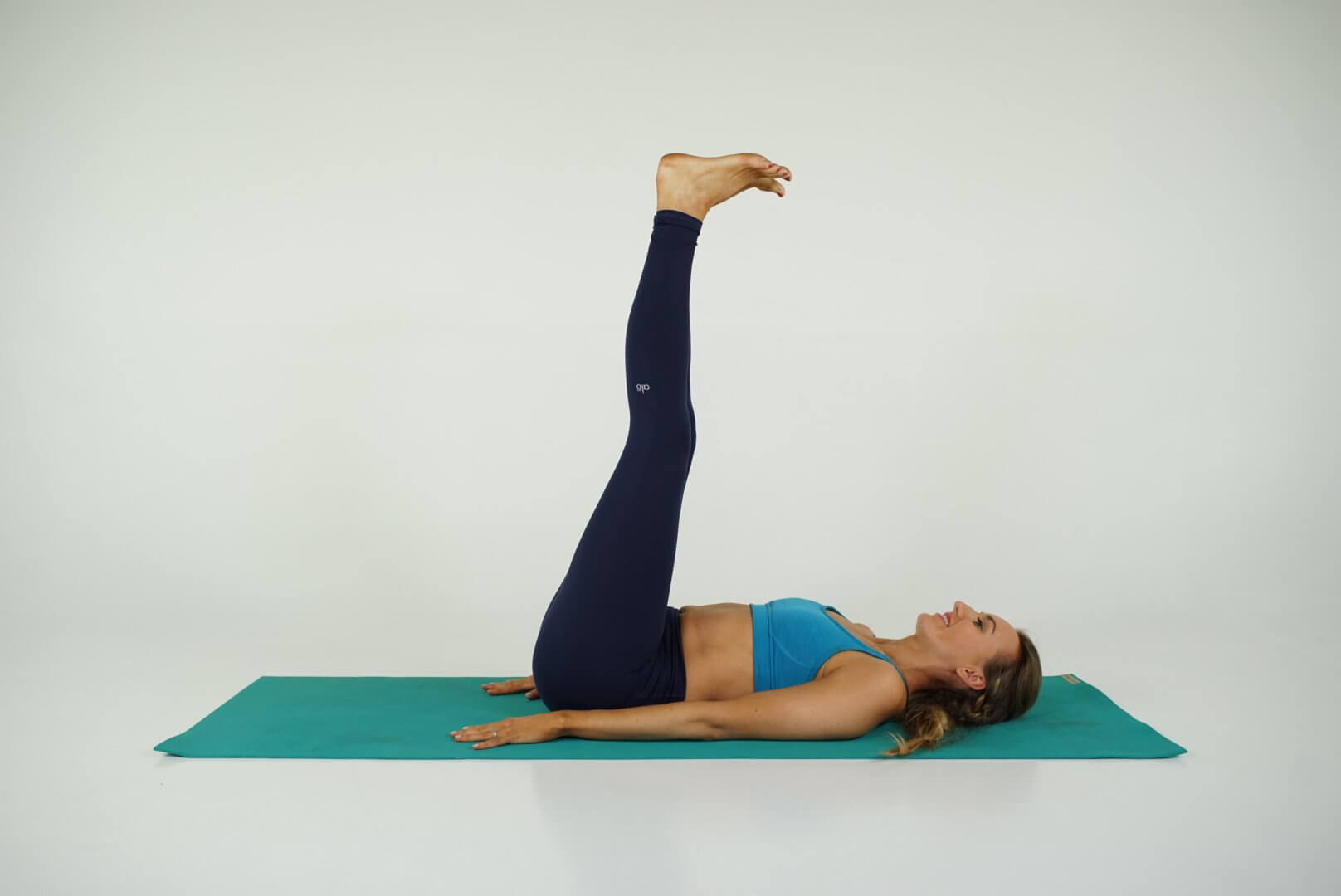
Steps to Practice:
- Sit sideways against a wall and swing your legs up as you lower your torso.
- Adjust so your hips are close to the wall and your back is fully supported.
- Rest here for 5-10 minutes, focusing on slow, steady breathing.
Variations:
Place a bolster under the hips for a mild inversion. You can also do this in bed with your legs against the headboard or on the back of the couch while watching your favorite show/reading.
Benefits:
Calms the nervous system and reduces stress and improves circulation promoting emotional balance.
Pro Tips for Yoga Teachers:
- Spread legs into a “V” shape for added hip opening.
- Encourage students to do a body scan here, or maybe a little progressive muscle relaxation.
6. Shaking Practice

Steps to Practice:
- Stand with feet hip-width apart and knees slightly bent.
- Begin shaking your hands, then arms and legs, progressing to the whole body, in a rhythmic motion.
- Gradually increase intensity, then slow down to stillness.
Variations:
Add stomping to release pent-up energy. Pair with deep exhales to amplify the release or sit in a chair and only shake the upper body or one lower body part at a time.
Benefits:
Discharges built-up physical tension and stress and energizes the body while promoting emotional catharsis.
Pro Tips for Yoga Teachers:
- Try doing this at the end of a grief class to discharge all of the energy that may have come up during the practice.
- Slow things down afterwards with some gentle hip circles, placing one hand on belly and one hand on heart.
Closing Thoughts
The grief journey is not a linear one and this part of the lived experience can make it hard in moving forward. You can learn how to support individuals through grief and loss with a more somatic approach by becoming an Embodied Yoga Life Coach. Even if you don’t want to coach others, you can learn to facilitate your own healing with modules on releasing specific emotions. When you start looking at things through a somatic lens you truly expand your ability to heal and move through life with greater ease.
Next Steps
- Take a deep dive into embodiment and somatic yoga with my Somatic Yoga certification program.
- If you’re interested in practical kriya yoga as a way to improve your daily life and relationships, check out my Yoga for Self Mastery course.
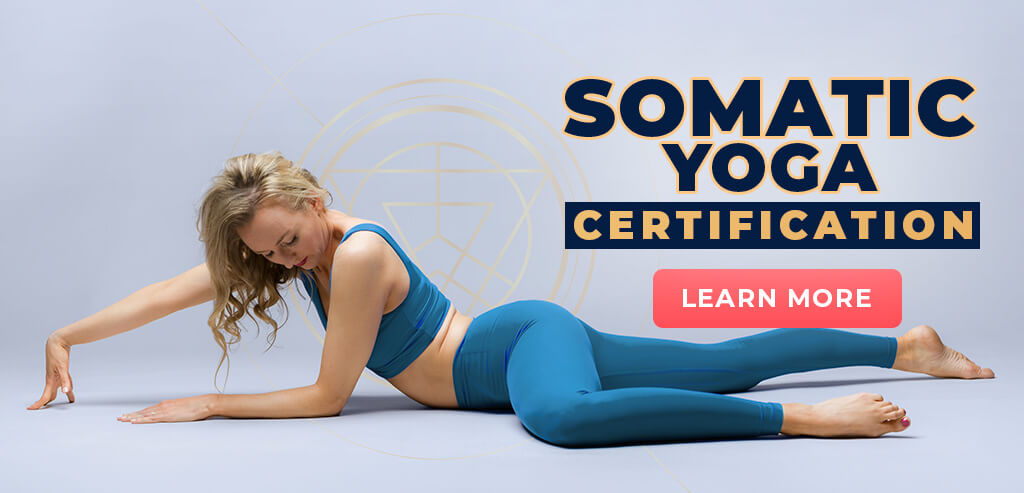
FREE Embodied Yoga Workshop (usually $67) Somatic Techniques & Cord Cutting Ritual
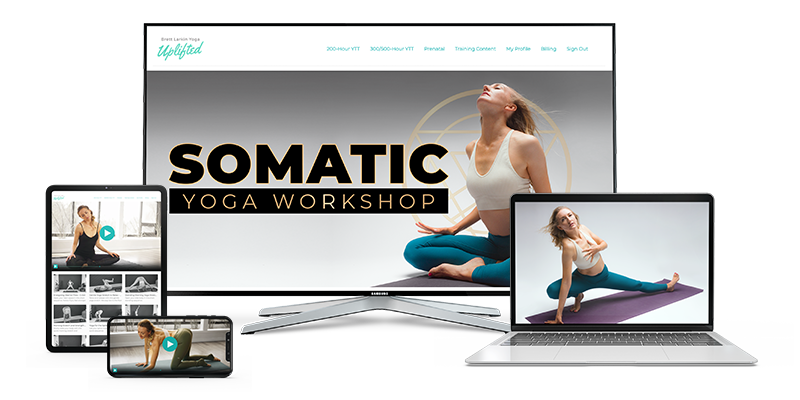
YOU MIGHT ALSO LIKE
- 7 Top Somatic Yoga Books to Regulate Your Nervous System
- 5 Best Somatic Yoga Apps for Nervous System Regulation
- Top Somatic Coaching Programs And How To Choose One
- Somatic Yoga Workshop Ideas for Teachers
- Somatic Yoga for Cortisol Detox: A Gentle Path to Stress Relief and Nervous System Healing
- Gentle Somatic Yoga: Heal Chronic Pain, Release Trauma, and Reclaim Your Bod
- Somatic Meditation: A Body-Based Approach to Healing Stress, Anxiety, and Trauma
- Advanced Pelvic Floor Breathing: A Somatic Approach to Healing
- Somatic Yoga For Yoga Teachers: Everything You Need to Know in 10 Steps
- How Somatic Shaking Can Release Tension and Reset Your Nervous System
- Discover Somatic Pilates: Enhance Your Body Awareness and Flexibility
- Kundalini for Feminine Energy: Ignite Your Creative Power and Passion
- 6 Effective Somatic Yoga for Neck and Shoulders
- How to Teach Somatic Yoga: A Practical Guide for Instructors
- The Best Somatic Exercises for Grief: Find Healing Through Movement

